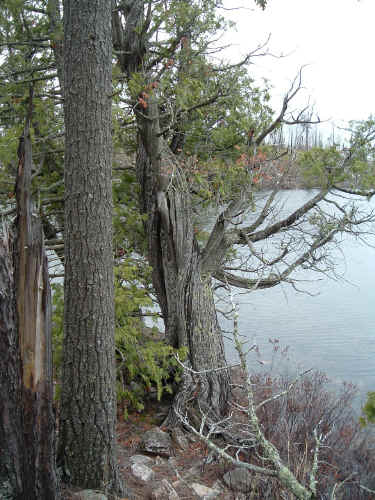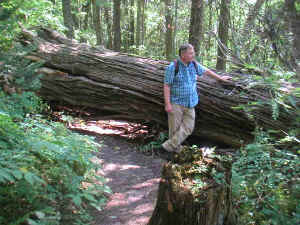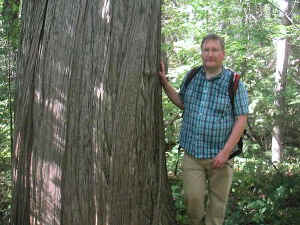| Northern
White
Cedar or Arborvitae (Thuja occidentalis) |

Northern white cedar that survived the 1999 blowdown and 2002
fire. Estimated age about 800 years (tree is hollow). Boundary
Waters Canoe Wilderness Area, MN |

White cedar swamp, Michigan State Fisheries Visitors Center,
MI |

White cedar bark on a young tree. |
 |
 |

Lee contemplates a fallen giant cedar that he estimated may
have been up to 900 years old. A cbh of 186 inches was measured
and the height of the tree when standing was estimated at 75 to
80 feet, South Manitou Island, MI |

One of the two main contenders for the title of
champion Thuja Occidentalis at this site with a measured height
of 77.7 feet, cbh of 145 inches and spread of nearly 24 feet. |
 |
|
|
|
- http://www.discover.com/issues/feb-96/features/theverticalfores693/
Lee Frelich commented Sept 29, 2006:
Clearly there is some nonsense in this article. For example,
that cedar
trees cannot survive long on a horizontal surface because of
their
architecture, and they tip over at a young age. On our 700
plots in the
big blowdown of 1999 in the Boundary Waters, white cedar had
the lowest
windthrow mortality rate of among all the species present.
Trees 200-400
years old that are standing vertically are common in many
places throughout
the midwest, including the Wisconsin part of the Niagara
Escarpment. Some
cedars do blow down and survive, and the species is more
likely to survive
after blowing down than any other species in the region. But
that doesn't
mean that trees can't survive if they are still standing
vertically.
|
|